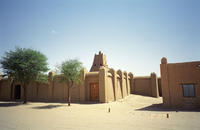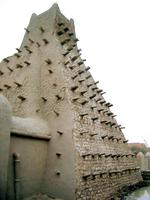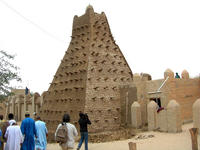You are in: Africa -> Mali -> Timbuktu, and traditional search or Image Gallery will yield results of this site only
Timbuktu
| Site number: | 119 |
|
| Type of site: | Heritage in danger | |
| Date: | 15-16th century | |
| Date of Inscription: | 1988 | |
| Location: | Africa, Mali, Circle and Region of Tombouctou | |
Up to 75 images are shown here. Click on each for more details or on Image Gallery for more images.
Six official UN languages:
Arabic,
Chinese,
English,
French,
Russian,
Spanish
Other languages: Aragonese, Bosnian, Croatian, Czech, Danish, Dutch, Farsi, Finnish, Georgian, German, Indonesian, Italian, Japanese, Lithuanian, Norwegian-bokmål, Polish, Portuguese, Serbian, Slovak, Swahili, Swedish, Turkish, Ukrainian, Welsh, Low German
Other languages: Aragonese, Bosnian, Croatian, Czech, Danish, Dutch, Farsi, Finnish, Georgian, German, Indonesian, Italian, Japanese, Lithuanian, Norwegian-bokmål, Polish, Portuguese, Serbian, Slovak, Swahili, Swedish, Turkish, Ukrainian, Welsh, Low German
| Description: | Timbuktu was known as a scholarly and spiritual capital as it housed the prestigious Koranic Sankore University as well as other madrasas, but it also acted as a centre for the spread of Islam throughout Africa in the 15th and 16th centuries. The site’s three grand mosques, Djingareyber, Sankore and Sidi Yahia, evoke the golden age of Timbuktu. Although these monuments have been continuously restored, in the present day they are endangered by desertification, which threatens to destroy them. --WHMNet paraphrase from the description at WHC Site, where additional information is available. | |
| Timbuktu (Archaic English: Timbuctoo; Koyra Chiini: Tumbutu; French: Tombouctou) is a city in Tombouctou Region, Mali. It is home to the prestigious Sankore University and other madrasas, and was an intellectual and spiritual capital and centre for the propagation of Islam throughout Africa in the 15th and 16th centuries. Its three great mosques, Djingareyber, Sankore and Sidi Yahya, recall Timbuktu's golden age. Although continuously restored, these monuments are today under threat from desertification. Timbuktu is populated by Songhay, Tuareg, Fulani, and Mandé people, and is about 15 km north of the River Niger. It is also at the intersection of an east–west and a north–south Trans-Saharan trade across the Sahara to Araouane. It was important historically (and still is today) as an entrepot for rock-salt from Taoudenni. Its geographical setting made it a natural meeting point for nearby African populations and nomadic Berber and Arab peoples from the north. Its long history as a trading outpost that linked west Africa with Berber, Arab, and Jewish traders throughout north Africa, and thereby indirectly with traders from Europe, has given it a fabled status, and in the West it was for long a metaphor for exotic, distant lands: "from here to Timbuktu." Timbuktu's long-lasting contribution to Islamic and world civilization is scholarship.By the fourteenth century, important books were written and copied in Timbuktu, establishing the city as the centre of a significant written tradition in Africa. --Wikipedia. Text is available under the Creative Commons Attribution-ShareAlike License. | ||
| Source: | http://whc.unesco.org/en/list/119 | |
| Reference: | 1. UNESCO World Heritage Center, Site Page. | |


























